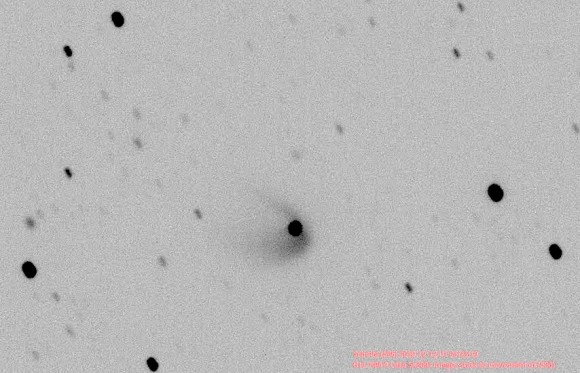
© Peter Lake(596) Scheila, the asteroid with a tail.
When is an asteroid not an asteroid? When it turns out to be a comet, of course. Has this ever happened before? Why, yes it has. In fact it was just announced December 12, 2010 that the asteroid (596) Scheila has sprouted a tail and coma! This is likely a comet that has been masquerading as an asteroid.
Steve Larson of the Lunar and Planetary Laboratory (LPL), University of Arizona first reported that images of the minor planet (596) Scheila taken on December 11th showed the object to be in outburst, with a comet-like appearance and an increase in brightness from magnitude 14.5 to 13.4. The cometary appearance of the object was confirmed be several other observers within hours.
A quick check of archived Catalina images of Scheila from October 18, November 2 and November 11 showed Scheila to look star-like, which is what asteroids look like from Earth. They just happen to be moving across the field of view in contrast to the fixed background stars. The image taken by Catalina on December 3rd shows some slight diffuseness and an increase in overall brightness. So, it appears this even began on or around December 3rd.
Upon hearing the news, there was some speculation that this might be evidence of an impact event. Had something crashed into asteroid Scheila? It seems unlikely, and this is a story we have heard before.
The asteroid discovered in 1979 and named 1979 OW7 was lost to astronomers for years and then recovered in 1996. It was subsequently renamed 1996 N2. That same year it was discovered to have a comet-like appearance, and many believed this was the signature of an impact between two asteroids. After years of inactivity 1996 N2 sprouted a tail again in 2002. One collision between two asteroids was unlikely enough. The odds of it happening again to the same object were essentially zero. What we had was a comet masquerading as an asteroid. This object is now known by its cometary name 133P/Elst-Pizarro, named after the two astronomers who discovered its initial cometary outburst.
The 2002 outburst and the discovery of more active asteroids showing mass-loss led to a paper (
Hsieh and Jewitt 2006, Science, 312, 561-563) introducing an entirely new class of solar system objects, Main Belt Comets (MBC). MBCs look like comets because they show comae and have tails but they have orbits inside Jupiter's orbit like main belt asteroids.
The most likely cause of the mass loss activity in MBCs is sublimation of water ice as the surface of the MBC is heated by the Sun. This is suggested most strongly by the behavior of the best-studied example, namely 133P/Elst-Pizarro. Its activity is recurrent, and it is strongest near and after perihelion, the point in its orbit nearest the Sun, like other comets.
MBCs are interesting to astronomers because they appear to be a third reservoir of comets in our solar system, distinct from the Oort cloud and Kuiper belt. Since we know of no way for theses other reservoirs to have deposited comets in the inner solar system, the ice in MBCs probably has a different history than the ice in the outer comets. This allows researchers to study the differences in the Sun's proto-planetary disk at three separate locations. This might lead to information on the Earth's oceans, one of the continuing lines of investigation by solar system scientists.
Now it seems we have another MBC to add to the sample. And Scheila will probably be getting a new name soon. Asteroid (596) Scheila was discovered Feb. 21, 1906, by A. Kopff at Heidelberg. The 113Km in diameter 'asteroid' was named after an acquaintance, an English student at Heidelberg. In the future it will be called XXXP/Lawson or something similar, and Kopff's Scheila will become just another footnote in the history of astronomical nomenclature.
Reader Comments
to our Newsletter